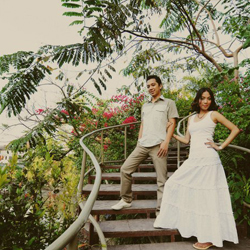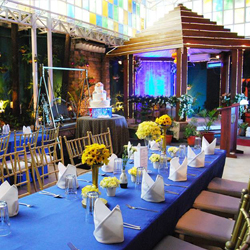Camiguin – Island Born of Fire
Camiguin is said to be ‘born of fire’, for the province has seven volcanoes in its territory. These are Mount Hibok-Hibok, Mount Vulcan, Mount Guinsiliban, Mount Mambajao, Mount Timpoong, Mount Tres Marias, and Mount Uhay. The most notable are Mount Hibok-Hibok and Mount Vulcan. The documented eruption of these two volcanoes shaped the province to what is its today.
Aside from the mentioned nickname, Camiguin is known as the Philippines’ Garden of Eden because of its unique and rich natural attractions. White Island, Old Vulcan, Ardent Hot Spring, Sto. Niño Cold Spring, and Mount Hibok-Hibok are some of its famed destination.
Demographic
- Population –81, 293 (as of 2007 Census)
- Land Area – 237.95 sq. km
- Capital –Mambajao
- Language/Dialect –Cebuano, Kinamigin, English, and Filipino
- Divisions
Cities (0)
Municipalities (5)
- Catarman
- Guinsiliban
- Mahinog
- Mambajao
- Sagay
Sunken Cemetery
A large cross marks the old cemetery that was swept
to the sea by Mt. Vulcan Daan’s eruption in 1871.
White Island
This uninhabited sandbar changes its shape according
to tide. It has the picturesque Mt. Hibok-Hibok as its
backdrop.
Panaad Festival
Held annually in observance of the Lenten Season, people
flock to the island and walk around a 64 km. circumferential
road as their “vow” to Christian faith.
Mt. Hibok
Hibok
It is the only active volcano among the seven others
in island. It has six hot springs and a volcanic maar.
Delectable
Food
The island province of Camiguin has an array of mouthwatering
delicacies that are a must-try and take-home for those
who will visit the province.
-
Turrones de mani - one the island’s traditional delicacies. It is a tube-like wafer with powdered milk inside and tablea which is a native chocolate. The method of making the delectable delicacy has not changed despite of the advancement technology.
-
Lanzones – This tropical fruit grows well in the North-Central coast of Mindanao. It is said that the sweetest lanzones in the Philippines comes from Camiguin.
-
Pastel – It is a soft, sweet bun stuffed with yema, a desert made from milk, eggs and sugar.
Cultural
Ancestral
House
Location: Mambajao, Camiguin
There are numerous ancestral house in Camiguin that
have been well preserved over the years. The two notable
ones are the ancestral house in Los Libertadores
St., Mambajao, now dwelled by the Francisco Family,
and the Centennial House in Lakas, Mambajao owned by
Corrales Family. Both houses were built in 1800's.
Historical
Sunken Cemetery
Location: Brgy. Bonbon, Catarman, Camiguin
The cemetery was once part of the old capital of the
province. The eruption of Mt. Vulcan Daan in 1871 sunk
Cotta Bato and the cemetery. In 1948, Mt. Vulcan Daan
erupted again submerging the entire cemetery. A large
cross built on solidiefied lava marks the old cemetery
that was swept to the sea by eruption. It is now a popular
dive site.
Catarman
Church Ruins (Ruins of Gui-ob Church or San Roque
Church)
Location: Gui-ob, Brgy. Bonbon, Catarman, Camiguin
What remains from the old church are ruins of adobe
walls, belfry and convent that are testimonials to the
devastating 1871 earthquake and volcanic eruption which
wiped out the illustrious town of Catarman established
earlier as a Spanish settlement in 1697.
Natural
Mt. Hibok-Hibok
Location: Brgy. Tagdo, Mambajao, Camiguin
It is a stratovolcano and dome complex with an elevation
of 1,332 meters above sea level and a base diameter
of 1,000 meters. It has six hot springs, three crater
lakes, and a volcanic maar. Its eruption in 1951 nearly
wiped out the whole population in Camiguin and caused
massive emigration. Now, it has become a popular hiking
site.
Mt. Vulcan
Daan
Location: Catarman, Camiguin
Towering at 671 meters high above sea level, Mt. Vulcan
Daan was created when Mt. Hibok-Hibok erupted in January
1871. Its eruption in May 1, 1871 sunk the cemetery
under water and destroyed San Roque Church.
Katibawasan
Falls
Location: Mambajao, Camiguin
The falls, which measures 256 feet high, cascades to
a rock pool surrounded by ground orchids, wild ferns,
trees and boulders. Its cold water provides an ideal
summer splash to bathers and picnickers.
Tuasan Falls
Location: Brgy. Mainit, Catarman, Camiguin
The pool below the deafening waterfalls is deep and
clear. The surrounding scenery is virgin and perfect
for a peaceful picnic. The only sound you hear is that
of the tumbling falls and running water.
Ardent Hot
Spring
Location: Brgy. Esperanza, Mambajao, Camiguin
It is a natural pool, with water coming from the bowels
of Mt. Hibok-Hibok. Its temperature is at 40 degree
Celsius. Dipping in its hot water is said to be the
best treatment for any therapeutic ailment because the
water contains sulfur, a medicinal element that can
cure illness. Picnic huts, cook-out facilities and restrooms
are available to accommodate the increasing number of
visitors.
Tangub Hot
Spring
Location: Brgy. Naasag, Mambajao, Camiguin
It is a volcanic hot spring not fully developed a little
beneath sea level where a pool is formed by sea stones
and corals. Water temperature shifts from cold to lukewarm
to warm then to hot as tide changes. Immerse in the
warm water inside the pool at low tide and enjoy the
cold sea water merging with the hot spring.
Sto. Nino
Cold Spring
Location: Catarman, Camiguin
The pool measuring 25 m x 40m is 11/2 meter deep with
cold spring water sprouting from its sandy bottom. The
area has picnic huts, cook-out facilities and restrooms
for picnickers.
White Island
(Medan Island)
Location: Yumbing, Mambajao, Camiguin
This small inhabited white sand bar, with picturesque
Mt. Hibok-Hibok and Mt. Vulcan as its backdrop. The
shape of the island depends on the tide. It is ideal
for swimming, sunbathing, snorkeling and shell collecting.
Mantigue
Island
Location: Mahinog, Camiguin
The island is 4 hectares of evergreen forest, fringed
with white granule sand beaches. A fishing village is
found in the north of the island. One side of the island
is a white sand beach with coral offshore, and the other
opposite side provides a deep drop-off for snorkeling
and diving.
Taguines
Lagoon
Location: Brgy. Benoni, Mahinog, Camiguin
Taguines LagoonIt is a lagoon mantled by limpid water,
large cliff and gently rolling hills. The brackish water
is engulfed in there by a century old crater, ideal
for boat and fishing.
Agohoy Beach
Location: Brgy. Agoho, Mambajao, Camigun
One of the favorite sandy beaches of the island. Native
cottages, multi-purpose building and a restaurant are
also available. It is also a preffered campsite for
Mt. Hibok-Hibok climbers.
Old Vulcan/
Old Volcano
Location: Mambajao, Camiguin
A unique underwater lava formation that rises from the
depths of more than 80 feet from the bottom forming
a series of pinnacles is the main attraction here. The
coral-covered molten rocks are surrounded by tropical
fishes. This is the landmark site for the Panaad Festival.
Religious
Sta. Rosario
Church
Location: Sagay, Camiguin
Built in 1882, the parish church of Sagay has been restored
because of natural decay. It features chandeliers made
of wood and other ornaments made from materials found
in the island.
Via Cruzes
Location: Old Vulcan, Mambajao, Camiguin
It is where life-size statues depicting the passion,
death, and resurrection of Jesus Christ - the 14 Stations
of the Cross that dot a trail to Old Volcano's peak
are found. At the last station is a sepulcher carefully
carved and chiseled out of volcanic rocks. The pilgrims
congregate here to pray during Lenten Season.
Festivals...
Panaad Festival
Place: Camiguin
Date: Holy Week
It is a yearly trek around the island in observance
of the Lenten season. Thousands of visitors converge
at the Walkway to the Old Volcano in Mt. Ilihan where
the Stations of the Cross are situated. Pilgrims walk
around the 64 kilometer-circumferential highway as a
form of sacrifice either in fulfillment of a vow or
in penance of sins.
Lanzones
Festival
Place: Camiguin
Date: Third to Fourth Week of October
The festival celebrates the harvest of the Camiguin's
Pride-Lanzones. This event also serves as thanksgiving
of the blessings that the island continually receives.
Highlights of the festival are Street Dancing &
Tableau Competitions, Mutya sa Buahanan (Miss Camiguin
Tourism) Beauty Pageant, Agro-Industrial-Technology
Trade Fair and Sporting Events.
San Juan
sa Hibok-Hibok Festival
Place: Mambajao, Camiguin
Date: June 24
Held annually in honor of St. John the Baptist, the
festival is highlighted with fluvial processions, parade,
water sports, and the annual beauty pageant which requires
contestants to have no makeup.
From Manila, take a flight to Cagayan de Oro City in Misamis Oriental. Once there, take a bus or any land-based transportation to Agora Bus Ternminal. Take a bus bound for Balingoan Port. Ride the ferry bound for Camiguin. The ferry docks at Benoni Port in Mahinog town or at Guinsiliban Port. Travel time from Balingoan is roughly one hour.
By Sea
From Cagayan de Oro City, there is a catamaran,
a type of multi-hulled boat or ship, bound straight
for Camiguin. There is also a ferry boat from Bohol
bound for Camiguin. The route docks at Balbagon
Wharf and Jagna, Bohol respectively.






